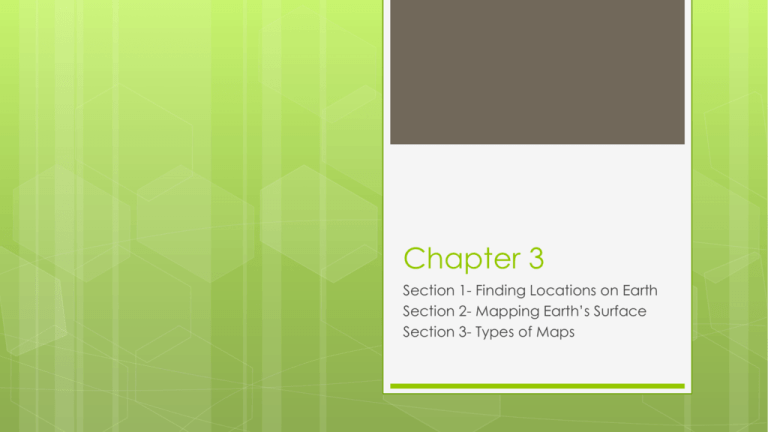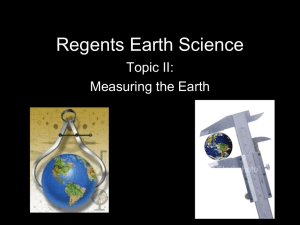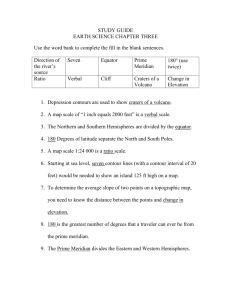Chapter 3
advertisement

Chapter 3 Section 1- Finding Locations on Earth Section 2- Mapping Earth’s Surface Section 3- Types of Maps Section 1- Finding Locations on Earth Objectives: 1. Distinguish between latitude and longitude. 2. Explain how latitude and longitude can be used to locate places on Earth. 3. Explain how a magnetic compass can be used to find directions on Earth’s surface. Introduction Earth is not a perfect sphere Earth has an axis Latitude What is latitude? What are Parallels? Latitude- Degrees of Latitude Measured in Degrees Actual Distance of 1° latitude is 111km The equator is designated 0° latitude The distance between the equator to either pole is ¼ of a circle Circle Parallels North of the Equator are labeled: 360° N (North) Parallels South of the Equator are labeled: S (South) Latitude- Minutes and Seconds Each Called minutes Each degree of latitude consists of 60 equal parts minute can be divided into 60 equal parts Called seconds This allows for a more precise location Longitude What is Longitude? What is Meridian? Longitude- Degree of Longitude Circle 360° Prime Meridian is at 0° Passes through Greenwich, England Meridian opposite of the Prime Meridian is 180° Locations E (East) Locations East of the Prime Meridian are labeled: W (West) West of the Prime Meridian are labeled: Longitude- Distance Between Meridians Measured in Degrees The actual distance between two longitudes is 111km All Meridians meet at the Poles The distance measured by a degree of longitude ↓as you move from the equator toward the poles Great Circles Often used for navigation A great circle is any circle that divides the globe in halves, or marks the circumference of the globe Finding Direction Magnetic Compass Geomagnetic Poles Located in a different place than the geographical poles Finding Direction- Magnetic Declination The angle between the direction of the geographic pole and the direction in which the compass needle points Has been determined for points all over Earth Because the Earth’s magnetic field is constantly changing, the magnetic declination around the globe also changes constantly Locating geographic north is important in navigation and in mapmaking Finding Direction- The Global Positioning GPS First GPS was launched in 1978 It calculates Latitude Longitude Altitude Section 2- Mapping Earth’s Surface Objectives: 1. 2. 3. Explain two ways that scientist get data to make maps. Describe the characteristics and uses of three types of map projections. Summarize how to use keys, legends, and scales to read maps. Introduction What is the purpose of a globe? Why do we have types of maps? How Scientist Make Maps Cartography Field surveys Take (Cartographers) measurements of an area Remote sensing Map Projections A map is a flat representation of Earth’s curved surface Distortion Size Shape Distance Direction Map Projection A flat map that represent the three-dimensional curved surface of a globe Map Projections Cylindrical Projection Azimuthal Projection Conic Projection Cylindrical Projection Azimuthal Projection Conic Projection Reading a Map Direction on a Map Symbols Map Scales Isograms Reading a Map- Map Legend Reading a Map- Map Scale Section 3- Types of Maps Objectives 1. 2. 3. Explain how elevation and topography are shown on a map Describe three types of information shown in geologic maps Identify two uses of soil maps Introduction Earth scientists use a wide variety of maps that show many distinct characteristic of an area. Some of these characteristics include: Types of rocks Differences in air pressure Varying depths of groundwater in a region Scientist also use maps to show: Locations Elevations Surface features of Earth. Topographic Maps Most widely used Show the surface features Natural features Rivers and hills Constructed features Buildings and roads Shows the elevation Height about sea level Topographic Maps- Advantages Provides more detailed information about the surface Shows Size Shape Elevation Topographic Maps- Elevation Contour Lines Show elevation Each contour line is an isogram that connects points that have the same elevation Contour Interval The difference in elevation between one contour line and the next Relief The shape of the contour lines reflects the shape of the land The difference in elevation between the highest and lowest points of the area being mapped Index Contours Bold lines that are labeled by elevation Topographic Maps- Landforms Contour lines spaced widely apart Contour lines spaced closely together Indicate the change in elevation is gradual Indicate the change in elevation is rapid and that the slope is steep Contour line that is a “V” shape Indicates a valley If a river or stream flows through the valley the “v” will point upstream The width of the “v” indicates the width of the valley Contour lines that form a closed loop indicates a hilltop or a depression Topographic Maps- Map Symbols Color The type of feature Constructed features are black Buildings, boundaries, road or railroads Major highways are red Bodies of water are blue Forested areas are green Contour lines are black or brown Areas not verified are purple Topographic Maps Geologic Maps Designed to show the distribution of geologic features Created on top of another map this called a Base Map Geologic Maps- Rock Units and Other Structures Geologic Unit A volume of rock of a given age range and rock type Distinguished by color Units of similar ages are generally assigned colors in the same color family Different shades of blue Other Markings Contact lines- indicates places at which two geological units meet called contacts Soil Maps- Soil Surveys and Uses Used to classify, map, and describe soils Soil Surveys Consists of 3 main parts Text, Use maps, and tables of Soil Maps Valuable tools for agriculture and land management Other Types of Maps Earth scientist also use maps to show the location and flow of both water and air These maps are commonly constructed by plotting data from various points around a region and then using isograms to connect the points whose data are identical Questions








